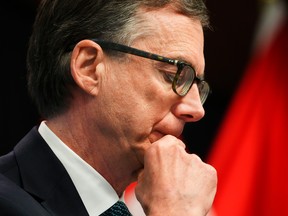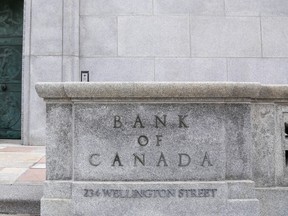Kevin Carmichael: ‘It’s like trying to land a helicopter on the head of a pin needle’
Article content
Inflation won’t be tamed without killing jobs. That’s why so few market participants think central banks in the United States, Europe, Canada and elsewhere can orchestrate a soft landing as they confront the biggest inflation scare since the 1980s.
Advertisement 2
Article content
“It’s like trying to land a helicopter on the head of a pin needle,” said Tom O’Gorman, director of fixed income at Franklin Templeton Canada.
But what if the positions that are wiped out by higher interest rates are unfilled, leaving households mostly unscathed?
Bank of Canada governor Tiff Macklem told reporters last week that he agreed that avoiding a hard landing will require some “delicate” manoeuvring. He’s also aware central bankers have rarely managed to choke inflation without harming the broader economy. Their preferred tool — the benchmark interest rate — doesn’t lend itself to deft manoeuvres.
Still, as Andrew Bailey, the Bank of England governor, said last week, a narrow path is still a walkable one. For Macklem’s part, he suggested skeptics might be discounting the unusually high number of unfilled positions. He doesn’t deny that there will be demand destruction from higher interest rates, but he thinks companies could respond by taking down job postings rather than throwing people out of work. In other words, a soft landing is possible because any nosedive will be aimed straight at a cushion of aspirational hiring, not existing employment.
Advertisement 3
Article content
“There is excess demand for labour,” Macklem said on a video call with journalists last week, citing the 830,700 job vacancies that Statistics Canada counted at the start of January, an increase of some 60 per cent from the first quarter of 2020.
“What that means is you can slow demand, you can reduce that demand for labour, and that reduces those unfilled jobs without actually putting someone out of work,” he continued. “If we can slow demand and bring it back into balance with supply, and we do think we are going to get reasonably good supply growth, we can bring those two things into balance and have the economy growing and bring inflation into balance.”
‘It’s imported inflation’
The comments shed light on why Macklem thinks this normalization of interest rates could be different than earlier episodes that didn’t end well. He directed reporters to the Bank of Canada’s new quarterly economic forecast, which assumes sufficient interest-rate increases to get inflation back to 2.4 per cent by the end of next year, while still achieving “pretty decent (economic) growth” of 4.2 per cent this year and 3.2 per cent in 2023.
Advertisement 4
Article content
“Why is that possible? The main reason is much of the inflation we have today is the result of global factors,” Macklem said. “It’s imported inflation. It’s inflation in internationally traded goods that is related to very disrupted supply chains, combined with strong global demand for goods.”
The governor conceded it’s difficult to predict when supply chains will get back to normal, but it’s safe to assume current pressures will eventually abate. When they do, inflation, which measures the rate of change of prices, will naturally ease. Prices could stick at higher levels, but the pace of change will slow. Businesses and households will again be able to plan on the assumption that prices will remain stable.
Macklem and his deputies have set a course to return the benchmark interest rate to “neutral,” which they define as somewhere between two per cent and three per cent. Most investors currently see the Bank of Canada moving its policy rate to the high end of that range, and Macklem has said it might be necessary to go a little higher to beat back inflation. (The benchmark rate is currently one per cent, after the central bank’s half-point lift on April 13.)
Advertisement 5
Article content
‘Over-leveraged economy’
To be sure, Macklem’s path back to a place of tame inflation and sustainable growth could be narrower than it looks. It’s an intriguing possibility that the Bank of Canada could destroy excess demand and the unemployment rate would still remain near its current record low of 5.3 per cent. But if the large number of unfilled positions provides the Bank of Canada with a greater margin of error, then an unprecedented level of debt takes at least some of it away. The consumption that has been powering Canada’s economy is likely sensitive to borrowing costs, meaning higher interest rates will weigh on demand even if the jobless rate stays low.
“Canada is an over-leveraged economy by any measure,” O’Gorman said. “I can’t help but think that growth is going to weaken.”
Advertisement 6
Article content
O’Gorman’s comments came after Statistics Canada last week reported that the consumer price index surged 6.7 per cent in March from a year earlier, the fastest pace since the early 1980s, save a brief spike of that magnitude in 1991.
Echoes from the early 1980s are getting louder. Inflation was out of control, driven higher by geopolitical confrontations, soaring oil prices and big government deficits. Former Federal Reserve chair Paul Volcker had to cause a recession to get inflation under control. The current era of inflation targeting, which sees central banks tie monetary policy to consumer price indexes, was created in the aftermath as policy-makers sought ways to avoid a repeat.
-

Tiff Macklem acknowledges inflation is running hotter than expected
-

Russia’s invasion of Ukraine has caused a rupture in the global order that is probably beyond repair: Tiff Macklem
-

Kevin Carmichael: Roaring inflation leaves Bank of Canada little choice but to come on strong
Advertisement 7
Article content
Macklem’s comments about how vacancies could be an under-appreciated buffer followed a question about why central banks thought that they could achieve a soft landing when so many of their closest observers doubted their ability to do so. He also pointed out that there were no inflation targets in the 1980s. No one knew what to expect from central banks, so expectations were based on the prevailing inflation numbers. That made everything worse.
Central banks are confronting this inflationary period after having the most controlled price pressures for three decades. That could help them bring down inflation without having to overdo it, as Volcker was forced to do.
“We’re not on autopilot,” Macklem said. “If interest rates really start to bite, if demand is slowing, and, importantly, if the outlook for inflation is really coming down, it may be time to pause so we don’t over-slow the economy.”
He added: “On the other hand, if you look at the economy right now, it’s got a lot of momentum. Households on average have a lot of extra savings in the bank. It may be that we need to take rates somewhat above neutral for a period to get inflation back to target.”
A narrow path, indeed.
• Email: kcarmichael@postmedia.com | Twitter: carmichaelkevin
Advertisement
Bank of Canada might pull off a soft landing, but it won’t be easy
2022-04-25 14:47:23






